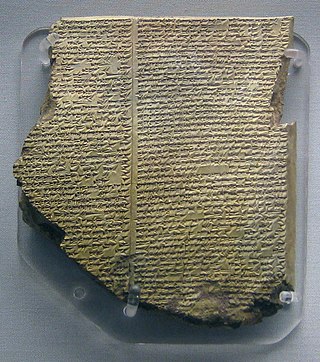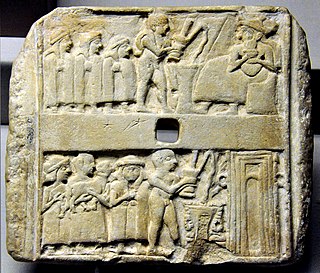
Gilgamesh was a hero in ancient Mesopotamian mythology and the protagonist of the Epic of Gilgamesh, an epic poem written in Akkadian during the late 2nd millennium BC. He was possibly a historical king of the Sumerian city-state of Uruk, who was posthumously deified. His rule probably would have taken place sometime in the beginning of the Early Dynastic Period, c. 2900 – 2350 BC, though he became a major figure in Sumerian legend during the Third Dynasty of Ur.

Inanna is the ancient Mesopotamian goddess of love, war, and fertility. She is also associated with sensuality, procreation, divine law, and political power. Originally worshipped in Sumer, she was known by the Akkadian Empire, Babylonians, and Assyrians as Ishtar. Her primary title was "the Queen of Heaven".
Akkadian literature is the ancient literature written in the Akkadian language in Mesopotamia during the period spanning the Middle Bronze Age to the Iron Age.

The Epic of Gilgamesh is an epic from ancient Mesopotamia. The literary history of Gilgamesh begins with five Sumerian poems about Gilgamesh, king of Uruk, some of which may date back to the Third Dynasty of Ur. These independent stories were later used as source material for a combined epic in Akkadian. The first surviving version of this combined epic, known as the "Old Babylonian" version, dates back to the 18th century BC and is titled after its incipit, Shūtur eli sharrī. Only a few tablets of it have survived. The later Standard Babylonian version compiled by Sîn-lēqi-unninni dates to somewhere between the 13th to the 10th centuries BC and bears the incipit Sha naqba īmuru. Approximately two-thirds of this longer, twelve-tablet version have been recovered. Some of the best copies were discovered in the library ruins of the 7th-century BC Assyrian king Ashurbanipal.

Disputation is a genre of literate involving two contenders who seek to establish a resolution to a problem or establish the superiority of something. An example of the latter is in Sumerian disputation poems.

Lugalbanda was a deified Sumerian king of Uruk who, according to various sources of Mesopotamian literature, was the father of Gilgamesh. Early sources mention his consort Ninsun and his heroic deeds in an expedition to Aratta by King Enmerkar.
Enkimdu (𒀭𒂗𒆠𒅎𒁺) was a Mesopotamian god associated with agriculture and irrigation. He is best known from the poem Dumuzi and Enkimdu, but in laments he was instead connected with the god Martu, who like Dumuzi could be described and depicted as a shepherd.

Sumerian literature constitutes the earliest known corpus of recorded literature, including the religious writings and other traditional stories maintained by the Sumerian civilization and largely preserved by the later Akkadian and Babylonian empires. These records were written in the Sumerian language in the 3rd and 2nd millennia BC during the Middle Bronze Age.

The "Debate between bird and fish" is an essay written in the Sumerian language on clay tablets, dating back to the mid to late 3rd millennium BC. It belongs to the genre of Sumerian disputation.

Sumerian religion was the religion practiced by the people of Sumer, the first literate civilization found in recorded history and based in ancient Mesopotamia. The Sumerians regarded their divinities as responsible for all matters pertaining to the natural and social orders.

Lugalbanda in the Mountain Cave is a Sumerian mythological account. It is one of the four known stories that belong to the same cycle describing conflicts between Enmerkar, king of Unug (Uruk), and an unnamed king of Aratta. The story is followed by another known as Lugalbanda and the Anzu Bird, together forming the two parts of one story. The stories, from the composer’s point of view, take place in the distant past. The accounts are believed to be composed during the Ur III Period, although almost all extant copies come from Isin-Larsa period. Tablets containing these stories were found in various locations of southern Iraq, primarily in the city of Nippur, and were part of the curriculum of Sumerian scribal schools during the Old Babylonian period.

The "Debate between sheep and grain" or "Myth of cattle and grain" is a Sumerian disputation and creation myth, written on clay tablets in the mid to late 3rd millennium BC.

The Debate between Winter and Summer or Myth of Emesh and Enten is a Sumerian creation myth belonging to the genre of Sumerian disputations, written on clay tablets in the mid to late 3rd millennium BC.

The Song of the hoe, sometimes also known as the Creation of the pickaxe or the Praise of the pickaxe, is a Sumerian creation myth, written on clay tablets from the last century of the 3rd millennium BCE.
Gilgamesh, Enkidu, and the Netherworld is one of five extant compositions of the Sumerian language about the deeds of the hero Gilgamesh. It was known to the ancients by its incipit, ud ri-a ud sud-rá ri-a or "In those days, in those faraway days". It spans 330 lines.
The "Series of the Poplar" is an Akkadian disputation poem containing a discussion between a Poplar, an Ash, and probably other trees, who each tries to establish his preeminence in the vegetal kingdom by listing their many uses and excellent qualities. Most of the surviving examples of the work are from the library of King Assurbanipal of Nineveh, "one of the most important repositories of texts from the entire ancient world".
Palm and Vine is a work of Akkadian literature. It contains a disputation poem between two litigants, Palm and Vine, each of which praises its own merits and many uses, and discredits those of its rival. The text may have been composed in the second-millennium BCE, but only first-millennium manuscripts of it are known. Fifty-four lines from the middle section of the text are preserved, which begin in medias res with a long speech of Palm, immediately followed by Vine's rejoinder. Three library manuscripts of the poem are known, as well as an excerpt on a peculiar school tablet.
The Debate between tree and reed is a work of Sumerian literature belonging to the genre of disputations poem. It was written on clay tablets and dates to the Third Dynasty of Ur. The text was reconstructed by M. Civil in the 1960s from 24 manuscripts but it is currently the least studied of the disputation poems and a full translation has not yet been published. Some other Sumerian disputations include the dispute between bird and fish, cattle and grain, and Summer and Winter.
The Debate between the hoe and the plough is a work of Sumerian literature and one of the six extant works belonging to this literature's genre of disputations poem. It was written on clay tablets and dates to the Third Dynasty of Ur and runs 196 lines in length. The text was reconstructed by M. Civil in the 1960s. The two protagonists, as in other disputation poems, are two inarticulate things: in this case, two pieces of agricultural equipment, the hoe and the plough. The debate is about which is the better tool.
The Debate between silver and copper is a work of Sumerian literature and one of the six extant works belonging to this literature's genre of disputations poem. It was written on clay tablets and dates to the Third Dynasty of Ur and runs 196 lines in length. The text was reconstructed by M. Civil in the 1960s. Like other Sumerian disputation poems, it features two typically inarticulate things debating over which one is superior.









